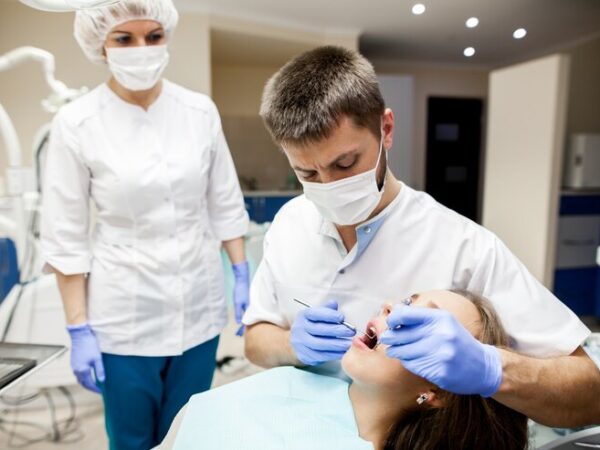Understanding Root Canal Causes and Risks
The Anatomy of a Tooth and Root Canal Infections
Understanding the anatomy of a tooth is crucial in recognizing how root canal infections develop. A tooth is composed of several layers: the outermost protective enamel, the sensitive dentin, and the inner pulp chamber that houses nerves and blood vessels. When bacteria breach these layers, it can lead to an infection of the pulp, known as a root canal infection.
- Enamel: The hard, protective outer layer.
- Dentin: A sensitive layer beneath the enamel.
- Pulp: The innermost chamber with nerves and blood vessels.
Infections occur when bacteria reach the pulp chamber, causing inflammation and pain. If left untreated, this can result in the death of the tooth and the need for a root canal procedure.
Early detection and treatment are key to preventing the progression of infection. Regular dental check-ups can identify potential issues before they escalate to a root canal infection.
Common Causes of Tooth Decay and Damage
Tooth decay and damage are primarily caused by bacteria in the mouth that produce acids, which can erode tooth enamel and lead to cavities. Poor oral hygiene is often the main culprit, as it allows plaque to build up and acids to damage the teeth.
- Bacteria & Plaque: The main cause of tooth decay is the bacteria that live in plaque, a sticky film that forms on teeth.
- Sugary Foods & Drinks: Consuming high amounts of sugar increases the risk of cavities, as sugar feeds the bacteria in plaque.
- Acidic Foods & Beverages: These can erode tooth enamel directly, weakening the teeth and making them more susceptible to decay.
- Poor Oral Hygiene: Not brushing and flossing regularly allows plaque to remain on the teeth and cause damage.
- Dry Mouth: Saliva helps to neutralize acids and wash away food particles. A lack of saliva can increase the risk of tooth decay.
Maintaining a consistent oral hygiene routine is essential in preventing the buildup of plaque and the progression of tooth decay. Regular brushing and flossing, along with professional dental cleanings, can significantly reduce the risk of developing cavities and the need for root canal treatment.
Risk Factors for Developing Root Canal Issues
Understanding the risk factors for root canal issues is crucial in learning how to avoid root canal procedures. Genetics, lifestyle choices, and certain health conditions can all play a role in increasing the likelihood of needing this treatment.
- Genetics: Some individuals are naturally predisposed to dental issues, including those that may lead to root canals.
- Lifestyle Choices: Habits such as smoking or poor oral hygiene can significantly increase the risk.
- Health Conditions: Diseases like diabetes can compromise oral health and lead to more frequent infections.
Maintaining awareness of these risk factors is the first step towards prevention. By addressing these areas, you can take proactive measures to protect your dental health and potentially avoid the need for a root canal.
It’s also important to consider the impact of trauma and previous dental work. Accidents that damage teeth and restorations that fail can expose the tooth to bacteria, leading to infection and the need for a root canal. Regular dental check-ups can help identify these issues early, before they escalate to more serious conditions.
Daily Oral Hygiene Practices
Brushing Techniques for Optimal Dental Health
Proper brushing techniques are essential for maintaining dental health and preventing the need for root canals. Brushing twice a day for two minutes is recommended by dental professionals to effectively remove plaque and prevent tooth decay.
- Use a soft-bristled toothbrush to avoid damaging the gums.
- Brush at a 45-degree angle to the gums, using short, gentle strokes.
- Don’t forget to brush the outer, inner, and chewing surfaces of each tooth.
- Use a fluoride toothpaste to strengthen tooth enamel and fight bacteria.
It’s not just about brushing often, but also brushing right. Technique matters to reach all areas of the mouth and to avoid causing harm to the gums and enamel.
Remember to replace your toothbrush every three to four months, or sooner if the bristles are frayed. A worn toothbrush won’t do a good job of cleaning your teeth.
The Role of Flossing in Preventing Dental Diseases
Flossing plays a crucial role in maintaining oral health by removing plaque and food particles from areas that a toothbrush can’t reach. Regular flossing can significantly reduce the risk of gum disease and tooth decay, which are leading causes of root canals.
- Daily Flossing: Essential for removing plaque to prevent tartar build-up.
- Proper Technique: Slide floss gently between teeth and along the gum line.
- Floss Selection: Choose the type that works best for your dental needs.
Flossing is not just about preventing cavities; it’s also vital for preserving the health of your gums. Neglecting to floss can lead to gingivitis, which can progress to more serious periodontal diseases if left untreated.
Incorporating flossing into your daily routine is a simple yet effective step towards safeguarding your dental health and avoiding invasive procedures like root canals. Remember, flossing is as important as brushing, and both should be part of your daily oral hygiene regimen.
Choosing the Right Dental Products for Your Teeth
Selecting the appropriate dental products is crucial for maintaining oral health. The market offers a wide variety of toothpastes and mouthwashes, each designed for specific dental needs. Whether you require extra fluoride, have sensitive teeth, or are looking to whiten your smile, there’s a product tailored for you.
It’s essential to choose a toothpaste with the American Dental Association (ADA) Seal of Acceptance, which ensures that the product meets strict safety and effectiveness criteria.
Here’s a simple guide to help you choose:
- Toothpaste: Look for fluoride content to prevent decay, and consider your specific needs such as tartar control, whitening, or sensitivity.
- Toothbrush: Opt for a soft-bristled brush to avoid damaging your gums, and consider an electric toothbrush for a more thorough clean.
- Mouthwash: Select an antiseptic mouthwash if you need to control plaque and gingivitis, or a fluoride mouthwash to help prevent tooth decay.
Remember, your dentist can provide personalized recommendations based on your oral health status.
Diet and Nutrition for Strong Teeth
Foods and Beverages to Avoid
Maintaining a healthy diet is crucial for dental health, particularly in avoiding foods and beverages that can lead to tooth decay and the need for a root canal. Sugary snacks, acidic drinks, and sticky candies are the primary culprits that can erode tooth enamel and promote bacterial growth.
- Sugary Snacks: Cookies, cakes, and other sweets can increase the risk of cavities.
- Acidic Drinks: Soda, citrus juices, and sports drinks can weaken enamel.
- Sticky Candies: Chewy treats like caramel can stick to teeth and cause decay.
Moderation is key when it comes to consuming these items. It’s not only about avoiding them entirely but also about limiting their intake and practicing good oral hygiene afterward.
In addition to these, starchy foods that can get trapped in your teeth, like chips and bread, should also be consumed in moderation. Drinking plenty of water, especially after meals, can help wash away food particles and reduce the risk of decay.
Essential Nutrients for Tooth Enamel Strength
Maintaining strong tooth enamel is crucial for preventing root canals, and this strength largely depends on the nutrients we consume. Calcium is the cornerstone of strong enamel, working to harden the outermost layer of our teeth and protect against decay.
Phosphorus plays a supporting role, partnering with calcium to bolster enamel strength. Vitamin D is essential as well; it helps the body absorb calcium and phosphorus effectively. Don’t overlook the importance of Vitamin A for maintaining the mucous membranes in the mouth, which help protect against bacteria.
Here’s a quick list of nutrient-rich foods that can help keep your teeth healthy:
- Dairy products like milk, cheese, and yogurt for calcium and phosphorus
- Leafy greens and almonds for calcium
- Fish and eggs for Vitamin D
- Carrots and sweet potatoes for Vitamin A
By incorporating these foods into your diet, you can fortify your tooth enamel and reduce the risk of dental issues that could lead to a root canal.
The Impact of Sugar on Dental Health
The relationship between sugar intake and dental health is well-documented. High sugar consumption can lead to tooth decay, as it provides food for bacteria that produce harmful acids in the mouth. These acids can erode tooth enamel, leading to cavities and potentially necessitating a root canal if the damage reaches the tooth’s pulp.
- Limit sugary snacks and drinks
- Rinse your mouth with water after consuming sugar
- Chew sugar-free gum to stimulate saliva production
Moderation is key in sugar consumption. Reducing the frequency and amount of sugar intake can significantly lower the risk of dental health issues.
It’s not just about the amount of sugar, but also the duration it stays in contact with the teeth. Sticky or slowly dissolving sweets pose a greater risk as they prolong the exposure of sugar to the teeth. Being mindful of sugar intake and following a disciplined oral hygiene routine can greatly reduce the chances of developing cavities and the subsequent need for a root canal.
Professional Dental Care and Regular Check-Ups
The Importance of Regular Dental Examinations
Regular dental examinations are a cornerstone of preventative dental care. Early detection of problems can save you from complex procedures like root canals in the future. These check-ups allow dentists to monitor your oral health and catch issues before they escalate.
- Visual Inspection: Your dentist looks for signs of decay, gum disease, and other oral health issues.
- Dental X-rays: These images help detect problems not visible to the naked eye, such as issues below the gum line.
- Cleaning: A professional cleaning removes plaque and tartar that brushing and flossing at home can’t.
Regular dental visits are not just about problem detection; they are a proactive approach to maintaining oral health. They provide an opportunity for your dentist to offer personalized advice on improving your dental care routine and to perform professional cleanings that bolster your efforts at home.
Professional Cleaning and Its Benefits
Professional dental cleanings performed by a rolling hills dentist or hygienist are not just about keeping your smile bright; they can have a significant impact on your general health. Insufficient oral hygiene has been linked to several serious illnesses. Professional cleanings can help to lower the risk of these conditions.
Regular professional cleanings can remove plaque, tartar, and stains that you are unable to remove yourself. They also provide an opportunity for your dentist to detect potential problems early on.
Benefits of professional dental cleaning include:
- Prevention of gum disease
- Early detection of oral health issues
- Removal of stains and discoloration
- Fresher breath
- Aiding in the prevention of oral cancer
By scheduling regular visits with your rolling hills dentist, you ensure that your teeth and gums receive the care they need to stay healthy. This proactive approach to dental health can save you from complicated procedures like root canals in the future.
When to Seek Treatment: Recognizing Early Signs of Trouble
Recognizing the early signs of dental issues is crucial in preventing the need for a root canal. Early intervention can often stop the progression of tooth decay and save the tooth. Regular self-examinations and being aware of changes in your dental health can help you catch problems before they escalate.
- Sensitivity to hot or cold temperatures
- Discoloration of the tooth
- Swelling and tenderness in the gums
- Persistent or recurring pimple on the gums
- Pain or discomfort when chewing or biting
It’s important to listen to your body and not dismiss minor discomforts. Dental pain or changes are signals that something may be wrong, and addressing these signs promptly with your dentist can be the difference between a simple filling and a more complex root canal procedure.
If you experience any of these symptoms, it’s advisable to schedule a visit with your dentist as soon as possible. Early diagnosis and treatment are key to maintaining dental health and avoiding more invasive procedures.
Advanced Preventative Measures
Sealants and Fluoride Treatments
Dental sealants and fluoride treatments are two proactive steps to stave off cavities and tooth decay. Sealants act as a barrier, protecting the grooves and depressions in the teeth from food particles and plaque. Typically applied to the chewing surfaces of the back teeth, sealants are especially beneficial for children and teenagers, whose oral hygiene practices may not be as thorough.
Fluoride, on the other hand, helps to rebuild weakened tooth enamel and reverses early signs of tooth decay. When applied in the dentist’s office, fluoride treatments contain a higher concentration of fluoride than what is found in drinking water or toothpaste.
- Sealants are usually clear or white and are not visible when you talk or smile.
- Floride treatments can come in the form of a gel, foam, or varnish.
Both treatments are quick, painless, and can be part of a regular dental visit. They are important components of a comprehensive dental care plan, particularly for individuals at high risk for dental caries.
The Use of Mouthguards to Prevent Injury
Mouthguards are an essential protective device for individuals participating in sports or activities that pose a risk to dental health. They act as a barrier to absorb and disperse the impact that could otherwise result in chipped, broken, or knocked-out teeth, and in some cases, may prevent the need for a root canal.
Mouthguards are not just for athletes. Anyone who grinds their teeth at night, known as bruxism, can also benefit from wearing a mouthguard to prevent tooth damage.
The effectiveness of mouthguards can vary based on the type and fit. Here’s a quick guide to the different types available:
- Stock mouthguards: Pre-formed and ready to wear, but often don’t fit well.
- Boil and bite mouthguards: Made from thermoplastic material that softens when boiled and then formed to the teeth by biting down.
- Custom-fitted mouthguards: Created by a dental professional from a mold of your teeth, offering the best protection and comfort.
It’s important to care for your mouthguard by cleaning it regularly and checking it for wear and tear. A well-maintained mouthguard is a key component in safeguarding your dental health.
New Technologies in Preventative Dentistry
Advancements in dental technology are revolutionizing the way we approach preventative care. Dr. Michael Chan, a leading figure in dental innovation, emphasizes the importance of staying abreast with the latest developments. One such advancement is the use of AI-driven analytics for early detection of dental issues, which can significantly reduce the need for interventions like root canals.
The integration of new technologies in dental practices is not just a trend; it’s a paradigm shift towards more proactive and personalized dental care.
Understanding the qualifications of professionals like Michael Chan, dentist with a DMD degree, is crucial. But what does DMD stand for in dentistry? It signifies a Doctor of Medicine in Dentistry, indicating a high level of training in dental medicine. Here’s how Dr. Michael Chan and his peers are applying their expertise with new technologies:
- Digital Imaging: Enhanced precision in identifying problem areas.
- Laser Dentistry: Minimally invasive procedures with quicker recovery times.
- 3D Printing: Custom dental appliances tailored to individual needs.
These innovations are not just for the future; they are being implemented today to ensure better dental health and to prevent complex procedures like root canals.
Conclusion
Maintaining dental health is essential to prevent the need for root canals and ensure a healthy, pain-free smile. By adhering to a thorough oral hygiene routine, making smart dietary choices, and visiting your dentist regularly, you can significantly reduce the risk of tooth decay and infection. Remember, prevention is always better than cure, and taking proactive steps to care for your teeth can save you from the discomfort and expense of advanced dental procedures. Embrace these practices as part of your daily life, and enjoy the lasting benefits of a strong, vibrant smile.













